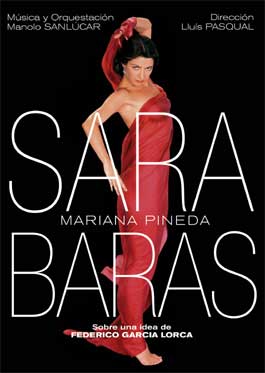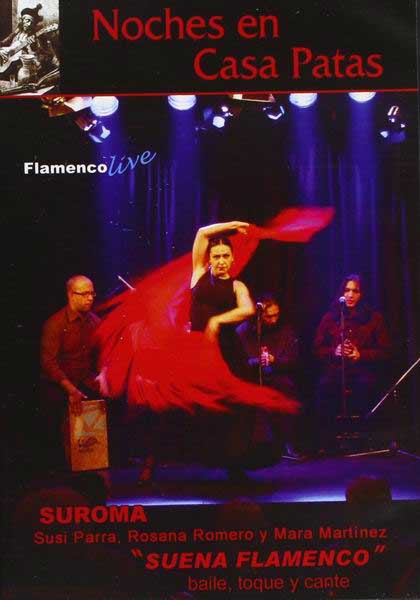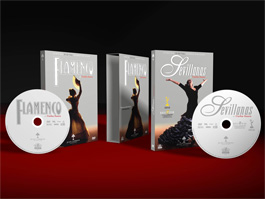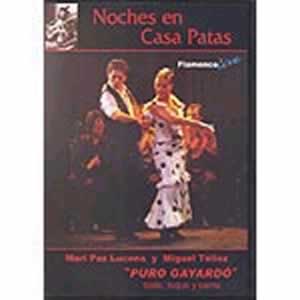- 🚚 📦 WORLDWIDE SHIPPING ✈️ 🌍
🚚 📦 WORLDWIDE SHIPPING ✈️ 🌍
Sara Baras: Mariana Pineda basada en una obra de Federico García Lorca. (dvd-Pal)
Ref: 50113SME329
27'95 €
Si el producto está en stock la salida es inmediata. Si no el tiempo de fabricación es de
$25'25
Quantity:
Available stock: 1
If the product is in stock the delivery is immediate. Otherwise, the fabrication time is 3 working days
The price in $ is an indicator, as the exchange rates are changing constantly.
Shipment period:
If the product is in stock the delivery is immediate. Otherwise, the fabrication time is 3 working days
Description:
'MARIANA PINEDA, DE SARA BARAS Y SU BALLET FLAMENCO'
In a superior performance of both Flamenco Ballet and Sara Baras art the version of MARIANA PINEDA is magnificent.
Mariana Pineda held in her hands, not to to defeat but to die for at a gallows, two weapons, love and freedom, that constantly stabbed her in the heart. Garcia Lorca wrote these words hours before the Buenos Aires release of this romance 'Romance popular e tres estampas' in which the Granadian poet recollected on the leyend that had been one of the 'great emotions' in his childhood.
She also held Sara Baras, but only to dance with the weapons of love and freedom. Sara Baras' story is also a tale of love. It is a story of love for flamenco and the dance from which she has created her own honest and emotional style. A style showing an unwavering desire for freedom which has made her one f the female figures with the most personality in Spanish dance today.
'Mariana Pineda' is a tale of love and freedom. These two sentiments wrap around this woman's heart, who walked the 90's Granada streets which motivated the author to the point of turning him into an unstopable motor that only death could stop. The 'Mariana Pineda' from Sara Baras, which is also from Lluis Pasqual and Manolo Sanlúcar, awaits her death within the darkness of her cell. Out of the shadows in her mind creep the memories of the three men that marked her recent life: Fernando, the young, impulsive and generous one who was not meant to be; Don Pedro de Sotomayor, the revolutionary who knew to captivate her and for whom she raises the voice of freedom; and Pedrosa, the impecable mayor who with his panting hands and fresh breath was always the poisoned temptation.
Mariana resigns to death and there she finds the man that will give life back to her: Federico García Lorca. He also died for venting his ideas in public and for wanting a new way.
Mariana finds in Lorca immortality and dances and once again gives the tone of her unmistakable voice.
In short, this is a great spectacle and a great piece of work by Federico García Lorca. In it, Sara Baras makes an appearance with her Flanenco Ballet for the audiences delight.
This performance was recorded live at the Teatro Calderón de Madrid. According to the production company, the recording published in digital format has been recorded with cutting edge technology. The recording also includes bonus material like interviews with Sara Baras and Lluís Pasqal, scenes from the making of the performance and pictures.
In a superior performance of both Flamenco Ballet and Sara Baras art the version of MARIANA PINEDA is magnificent.
Mariana Pineda held in her hands, not to to defeat but to die for at a gallows, two weapons, love and freedom, that constantly stabbed her in the heart. Garcia Lorca wrote these words hours before the Buenos Aires release of this romance 'Romance popular e tres estampas' in which the Granadian poet recollected on the leyend that had been one of the 'great emotions' in his childhood.
She also held Sara Baras, but only to dance with the weapons of love and freedom. Sara Baras' story is also a tale of love. It is a story of love for flamenco and the dance from which she has created her own honest and emotional style. A style showing an unwavering desire for freedom which has made her one f the female figures with the most personality in Spanish dance today.
'Mariana Pineda' is a tale of love and freedom. These two sentiments wrap around this woman's heart, who walked the 90's Granada streets which motivated the author to the point of turning him into an unstopable motor that only death could stop. The 'Mariana Pineda' from Sara Baras, which is also from Lluis Pasqual and Manolo Sanlúcar, awaits her death within the darkness of her cell. Out of the shadows in her mind creep the memories of the three men that marked her recent life: Fernando, the young, impulsive and generous one who was not meant to be; Don Pedro de Sotomayor, the revolutionary who knew to captivate her and for whom she raises the voice of freedom; and Pedrosa, the impecable mayor who with his panting hands and fresh breath was always the poisoned temptation.
Mariana resigns to death and there she finds the man that will give life back to her: Federico García Lorca. He also died for venting his ideas in public and for wanting a new way.
Mariana finds in Lorca immortality and dances and once again gives the tone of her unmistakable voice.
In short, this is a great spectacle and a great piece of work by Federico García Lorca. In it, Sara Baras makes an appearance with her Flanenco Ballet for the audiences delight.
This performance was recorded live at the Teatro Calderón de Madrid. According to the production company, the recording published in digital format has been recorded with cutting edge technology. The recording also includes bonus material like interviews with Sara Baras and Lluís Pasqal, scenes from the making of the performance and pictures.
Reviews:
'MARIANA PINEDA, DE SARA BARAS Y SU BALLET FLAMENCO'
In a superior performance of both Flamenco Ballet and Sara Baras art the version of MARIANA PINEDA is magnificent.
Mariana Pineda held in her hands, not to to defeat but to die for at a gallows, two weapons, love and freedom, that constantly stabbed her in the heart. Garcia Lorca wrote these words hours before the Buenos Aires release of this romance 'Romance popular e tres estampas' in which the Granadian poet recollected on the leyend that had been one of the 'great emotions' in his childhood.
She also held Sara Baras, but only to dance with the weapons of love and freedom. Sara Baras' story is also a tale of love. It is a story of love for flamenco and the dance from which she has created her own honest and emotional style. A style showing an unwavering desire for freedom which has made her one f the female figures with the most personality in Spanish dance today.
'Mariana Pineda' is a tale of love and freedom. These two sentiments wrap around this woman's heart, who walked the 90's Granada streets which motivated the author to the point of turning him into an unstopable motor that only death could stop. The 'Mariana Pineda' from Sara Baras, which is also from Lluis Pasqual and Manolo Sanlúcar, awaits her death within the darkness of her cell. Out of the shadows in her mind creep the memories of the three men that marked her recent life: Fernando, the young, impulsive and generous one who was not meant to be; Don Pedro de Sotomayor, the revolutionary who knew to captivate her and for whom she raises the voice of freedom; and Pedrosa, the impecable mayor who with his panting hands and fresh breath was always the poisoned temptation.
Mariana resigns to death and there she finds the man that will give life back to her: Federico García Lorca. He also died for venting his ideas in public and for wanting a new way.
Mariana finds in Lorca immortality and dances and once again gives the tone of her unmistakable voice.
In short, this is a great spectacle and a great piece of work by Federico García Lorca. In it, Sara Baras makes an appearance with her Flanenco Ballet for the audiences delight.
This performance was recorded live at the Teatro Calderón de Madrid. According to the production company, the recording published in digital format has been recorded with cutting edge technology. The recording also includes bonus material like interviews with Sara Baras and Lluís Pasqal, scenes from the making of the performance and pictures.
In a superior performance of both Flamenco Ballet and Sara Baras art the version of MARIANA PINEDA is magnificent.
Mariana Pineda held in her hands, not to to defeat but to die for at a gallows, two weapons, love and freedom, that constantly stabbed her in the heart. Garcia Lorca wrote these words hours before the Buenos Aires release of this romance 'Romance popular e tres estampas' in which the Granadian poet recollected on the leyend that had been one of the 'great emotions' in his childhood.
She also held Sara Baras, but only to dance with the weapons of love and freedom. Sara Baras' story is also a tale of love. It is a story of love for flamenco and the dance from which she has created her own honest and emotional style. A style showing an unwavering desire for freedom which has made her one f the female figures with the most personality in Spanish dance today.
'Mariana Pineda' is a tale of love and freedom. These two sentiments wrap around this woman's heart, who walked the 90's Granada streets which motivated the author to the point of turning him into an unstopable motor that only death could stop. The 'Mariana Pineda' from Sara Baras, which is also from Lluis Pasqual and Manolo Sanlúcar, awaits her death within the darkness of her cell. Out of the shadows in her mind creep the memories of the three men that marked her recent life: Fernando, the young, impulsive and generous one who was not meant to be; Don Pedro de Sotomayor, the revolutionary who knew to captivate her and for whom she raises the voice of freedom; and Pedrosa, the impecable mayor who with his panting hands and fresh breath was always the poisoned temptation.
Mariana resigns to death and there she finds the man that will give life back to her: Federico García Lorca. He also died for venting his ideas in public and for wanting a new way.
Mariana finds in Lorca immortality and dances and once again gives the tone of her unmistakable voice.
In short, this is a great spectacle and a great piece of work by Federico García Lorca. In it, Sara Baras makes an appearance with her Flanenco Ballet for the audiences delight.
This performance was recorded live at the Teatro Calderón de Madrid. According to the production company, the recording published in digital format has been recorded with cutting edge technology. The recording also includes bonus material like interviews with Sara Baras and Lluís Pasqal, scenes from the making of the performance and pictures.

















